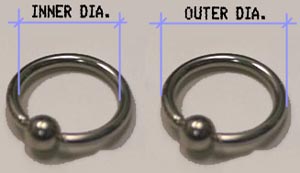Diameter
Jump to navigation
Jump to search
Body jewelry in a ring configuration is always measured by inner diameter. In smaller gauges, this doesn't make much difference, but when you consider a 2ga ring, the inner diameter may be 3/4", but because the metal itself is so thick, the outer diameter of the ring could possibly be over an inch and a quarter.
It is important that ring diameter be chosen in a "piercing-appropriate" fashion - for example, a common mistake for inexperienced piercers is to use rings with too small a diameter for nipple piercings (for example, 3/8" rings in a female nipple), failing to account for normal swelling during healing, and erection/contraction related to temperature, leading to rejection.
